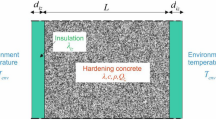Abstract
For the evaluation of the risk of thermal cracking in hardening massive concrete elements, knowledge of the development of strength and deformability of early-age concrete is extremely important. Based on an extensive experimental research program on hardening concrete elements, a degree of hydration-based description for the compressive strength, Young's modulus, the uniaxial tensile strength, the splitting tensile strength, the flexural tensile strength, Poisson's ratio and the peak strain are all worked out. An extension of the formulation of Sargin for the stress-strain relation for short-term compressive loading leads to a degree of hydration-based stress-strain relation for hardening concrete. Good agreement with experimental results is reported.
Résumé
Pour bien évaluer le risque de fissuration thermique dans un béton jeune, il est très important de pouvoir en déterminer d'une manière fiable les caractéristiques mécaniques. Sur la base de plusieurs essais mécaniques effectués sur le béton pendant sa phase d'hydratation, on a pu établir une expression qui relie au degré d'hydratation la résistance à la compression, le module d'élasticité, la résistance à la traction, la résistance à la flexion, la résistance à la traction par fendage, le coefficient de Poisson et la déformation à la contrainte maximale. Une extension de la relation “contrainte-déformation” établie par Sargin pour un béton durci, mène à une expression basée elle aussi sur le degré d'hydration. Pour l'ensemble des caractéristiques étudiées, on peut constater une bonne concordance entre les résultats et les relations proposées.
Similar content being viewed by others
References
Van Damme, L., Taerwe, L., Dedeyne, R. and De Rouck, J., ‘Quality and durability of concrete armour units’, Proc. of the 21st Coastal Engineering Conference, Vol. 3, Chapter 156, ASCE New York, 1988, pp. 2102–2115.
Dechaene, R., De Rouck, J., De Schutter, G., Taerwe, L. and Van Der Weeen, F., ‘Thermal cracking in hardening concrete armour units’, PIANG Bulletin, 1994, 82, pp. 61–69.
De Schutter, G. and Taerwe, L., ‘General hydration model for portland cement and blast furnace slag cement’,Cement & Concrete Research, 1995,25(3) 593–604.
De Schutter, G. and Taerwe, L., ‘Specific heat and thermal diffusivity of hardening concrete’,Magazine of Concrete Research, 1995,47 (172) 203–208.
Torrenti, J.M., ‘La résistance du béton au très jeune âge’, Bull. Liaison Labo P. et Ch., 179, Mai–Juin 1992, pp. 31–41.
Hamfler, H., ‘Berechnung von Temperatur-, Feuchte- und Verschiebungsfeldern in erhärtenden Betonbauteilen nach der Methode der finiten Elemente’, Deutscher Ausschus für Stahlbeton, Beuth Verlag GmbH, Berlin, 1988.
Horden, W.C. and Reinhardt, H.W., ‘Temperatuur en spanningen in tetrapods tijdens de verharding’, Cement 1986, nr. 12, pp. 49–52.
Rostasy, F.S. and Laube, M., ‘Experimental and analytical planning tools to minimize thermal cracking of young concrete’, RILEM proceedings 11, Testing during concrete construction, pp. 207–223.
Rostasy, F.S., Gutsch, A. and Laube, M., ‘Creep and relaxation of concrete at early ages-experiments and mathematical modeling’, Proceedings of the 5th international RILEM Symposium on Creep and Shrinkage of Concrete, Barcelona, 1993, pp. 453–458.
Maatjes, E. and Berlage, A.C.J., ‘Beheersing van het verhardingsproces’, Cement 1989, nr. 3, pp. 56–62.
Van Breugel, K., ‘Simulation of hydration and formation of structure in hardening cement-based materials’, Ph.D. dissertation, Delft, 1991.
Weigler, H. and Karl, S., ‘Junger Beton, Teil 1: Beanspruchung-Festigkeit-Verformung’, Betonwerk+Fertigteil-Technik, Heft 6/1974, pp. 392–401.
Breitenbücher, R., ‘Zwangspannungen und Rissbildung infolge Hydratationswärme’, Dissertation, Technischen Universität München, 1989.
Neville, A.M., ‘Properties of Concrete’, Pitman Publishing Cie, London, 1963.
Oluokun, F.A., Burdette, E.G. and Deatherage, J.H., ‘Elastic moduli, Poisson's ratio and compressive strength relationships at early ages’,ACI-Mat.J., Jan–Feb. 1991, 3–10.
Branco, F.A., Mendes, P.A. and Mirambell, E., ‘Heat of hydration effects in concrete structures’,ACI-Mat.J., Mar–Apr. 1992, 139–145.
Kral, S. and Becker, F., ‘Zur Entwicklung mechanischer Betoneigenschaften im Frühstadium der Erhärtung’,Beton 9/76, 315–320.
CEB-FIP Model Code 1990, CEB Bulletin d'information no 213/214, May 1993.
Derflinger, F., ‘Bemessung dicker Fundamentplatten für Eigen- und Zwangbeanschpruchung im Hinblick auf die Beschränkung der Stahlspannung und der Rissbreite’, Betonwerk+Fertigteil-Technik, Heft 12/1986, pp. 809–814.
Bastus, E., Carol, I., Mirambell, E. and Vazquez, E., ‘Estudio Thermico y tensional de grandes bloques de hormigon fiente a la accion del calor de fraguado’, Departamento de Ingenieria de la Construcción de la Universidad Politécnica de Cataluna, Marzo 1990.
Oluokun, F.A., Burdette, E.G. and Deatherage, H.J.H., ‘Splitting tensile strength and compressive strength relationship at early ages’,ACI-Mat.J., March–April 1991, 115–121.
Truman, K.Z., PetruskaA, D.J. and Norman, C.D., ‘Creep, shrinkage and thermal effects on mass concrete structures’,Journal of Eng. Mech.,117, no 6, June 1991, 1274–1288.
RILEM Commission 42-CEA, ‘Properties of set concrete at early ages’, State-of-the-art-report.Mat. et Constr.,14, no 84, 399–450.
Bournazel, J.P., ‘Contribution à l'étude du caractère thermomécanique de la maturation du béton’, Thèse de Doctorat de l'Université Paris 6, 1992.
Brameshuber, W. and Hilsdorf, H.K., ‘Development of strength and deformability of very young concrete’, SEM/RILEM International Conference on Fracture of Concrete and Rock, Houston, Texas, June 1987, pp. 409–421.
Author information
Authors and Affiliations
Additional information
Editorial note Prof. Dr. Ir. L. Taerwe is a RILEM Senior Member.
Rights and permissions
About this article
Cite this article
De Schutter, G., Taerwe, L. Degree of hydration-based description of mechanical properties of early age concrete. Mat. Struct. 29, 335–344 (1996). https://doi.org/10.1007/BF02486341
Issue Date:
DOI: https://doi.org/10.1007/BF02486341




